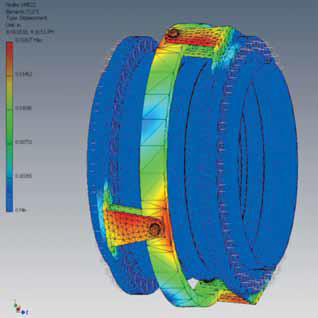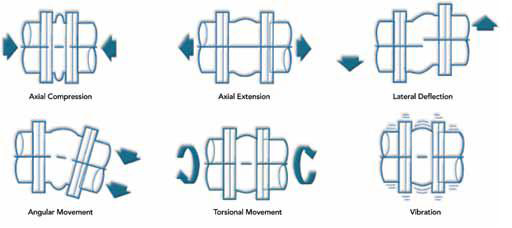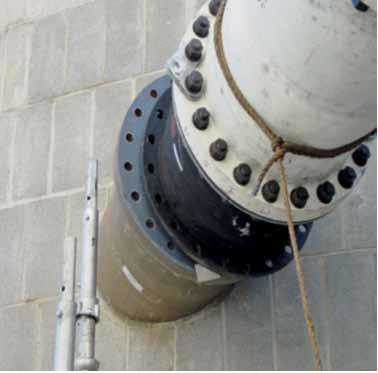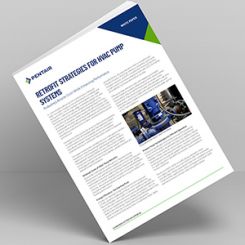Rubber expansion joints have long been recognized for reducing pipe and anchor stresses. Unfortunately, for equally as long, they have been viewed as being the weak link in any piping system. That an engineer would look to eliminate any inherent reliability risk is understandable, and with the advancements in pipe stress analysis, they have the tools to design the system without expansion joints.
Why are rubber expansion joints needed? The answer starts with disputing the theory that rubber expansion joints are a piping system's weak link. In fact, with finite element analysis (FEA) and strong engineering principals, it can be verified that the rubber expansion joints have an equal or greater safety factor than the adjacent piping or equipment.
The answer continues with the numerous design advantages that can only be obtained with the use of rubber expansion joints. These advantages can and should be quantified and added to pipe stress analysis data bases. This will enhance the tools available to engineers.
 |
| Figure 1. Expansion joint FEA |
Performance and Reliability
Improved performance and reliability are directly related to the materials of construction and engineering design. Rubber is one of the most compliant and resilient materials available. This not only makes it an ideal material for car tires but for expansion joints as well. With a flexing cycle life in the tens of millions, fatigue is not a design concern.
Improved performance and engineered solutions are often accomplished by incorporating advanced materials and technologies into what would otherwise be considered a conventional product line. Advanced materials would include premium elastomeric compounds, tire cord and high tensile steel reinforcements. Using tire cord is a good example of optimizing a design with advanced materials.
Tire cord is engineered with a resorcinol-formaldehyde latex (RFL) coating for superior bonding to the rubber. The cords themselves can be aligned on an optimal-bias, ply angle, offering tailored strength in the directions needed. This often eliminates delamination and reduces the total number of plies required. The result is improved performance in the form of increased movement capability, decreased spring rates and improved reliability.
Today's rubber expansion joints are designed by licensed engineers using advanced software for simulation and FEA. Documented safety factors can equal or exceed that of the adjacent piping and equipment.
Critical design elements of piping systems are support and flexibility. An obvious consequence of inadequate support is catastrophic and potentially life-threatening system failure.
Less obvious, however, is that inadequate flexibility can produce the sa`me devastating consequence. System flexibility is required to absorb thermal movements, ground settlement, misalignment, vibration and shock.
The features and benefits of rubber expansion joints include absorbing these forces and displacements, and replacing them with the rubber expansion joint's low stiffness (spring rate). They absorb noise and vibration and provide easy access to piping and equipment.
Absorbs all Directional Movement
Rubber expansion joints provide superior movement capability in axial compression, axial extension and lateral deflection, as well as in the angular and torsional direction. This performance cannot be obtained with metallic joints, grooved couplings or large pipe loops. The low stiffness and deflection forces can and should be incorporated into data bases accessed by pipe stress analysis programs.
 |
| Figure 2. Absorbs all directional movements and vibration |
Reduces Noise and Vibration
Rubber expansion joints dampen and insulate against the transmission of noise and vibration generated by mechanical equipment. This is important in HVAC applications where the disturbing frequency of pipe and fluid-conducting noise can resonate and amplify throughout a building. Metallic joints and grooved couplings do little to reduce noise and vibration.
High Resistance to Shock
The compliant and resilient characteristics of rubber expansion joints make them suited for earthquake and bomb blast isolation. They are also effective for pressure-surge and water hammer dampening.
Relieves Pipe and Anchor Stress
Thermal movements along with other external forces and displacements, including ground settlement, can exceed the allowable pipe and anchor stresses. Ground settlement is a good example of unanticipated system conditions that, without an expansion joint, could develop into serious problems. Rubber expansion joints absorb these stresses and replace them with their low stiffness (spring rate).
Compensates for Misalignment
It is common in both new construction and replacement applications to encounter pipe misalignment. Minor misalignment can be corrected with standard expansion joints, and custom units can be fabricated with large permanent offsets. The custom fit units are easier to install and will have a longer, maintenance-free life.
 |
| Figure 3. Large pipe misalignment |
Provides Access to Piping and Equipment
Access to piping and equipment can be easily achieved by treating the rubber expansion joint as a removable spool piece. If a self retracting design is needed, a dismantling joint can be used. This is another example of system difficulties that may arise without the use of rubber expansion joints.
Conclusion
Rubber expansion joints have numerous design advantages—including their enhanced construction and expansive application capabilities. They should not be viewed as the weak link in the piping system. Instead, they are a functional component that has little or no alternative replacements.
In addition, expansion joints can adapt to misalignment that is often found in modular construction. Ultimately, the use of rubber expansion joints is imperative for a successful operation on all functional levels. Although stress analyses can ensure proper pipe design codes, expansion joints safely accommodate variables and contingencies and enhance the system's overall reliability and performance.
Quantifying and incorporating these design advantages into useful data bases will ultimately enhance the pipe stress analysis program and its applications.
Pumps & Systems, December 2010
Fluid Sealing Association
"Sealing Sense" is produced by the Fluid Sealing Association as part of our commitment to industry consensus technical education for pump users, contractors, distributors, OEMs, and reps. As a source of technical information on sealing systems and devices, and in cooperation with the European Sealing Association, the FSA also supports development of harmonized standards in all areas of fluid sealing technology. The education is provided in the public interest to enable a balanced assessment of the most effective solutions to pump systems technology issues on rational Total Life Cycle Cost principles.
The Piping Systems Non-Metallic Expansion Joint division of the FSA is one of six with a specific product technology focus. As part of their mission they develop publications such as the newly revised seventh edition Technical Handbook Non-Metallic Expansion Joints and Flexible Pipe Connectors and the Non-Metallic Piping Expansion Joint Installation Guide. The former provides construction, installation, and application details while the latter is a “hands-on” simplified guide for maintenance operators and engineers. Both are primers intended to complement manufacturer's documents produced by the member companies. In addition, standards such as FSA-PEJ-701-06 Piping Systems Non-Metallic Expansion Joint Hydrotesting and Vacuum Testing, FSA-PEJ-702-06 Rubber Flanged Non-Metallic Expansion Joint Installation, Maintenance, and Storage, and FSA-NMEJ-703-99 Specifications of Elastomers Used in Piping Systems Non-Metallic Expansion Joints have been developed in response to important user issues.
Following members of the Piping Systems Non-Metallic Expansion Joint division sponsor this "Sealing Sense" series:
- Bachmann Dampjoint, Inc.
- Daikin America, Inc.
- Dinatecnica Ind. E Com.
- DuPont Performance Elastomers L.L.C.
- 3M Dyneon
- Garlock Sealing Technologies
- General Rubber Corp.
- KE-Burgmann A/S
- Meccom Industrial Products Co.
- Mercer Rubber Company
- The Metraflex Co.
- Proco Products, Inc.
- Solvay Solexis, Inc.
- Unaflex Incorporated

